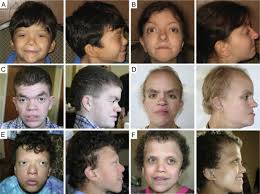 The RASopathies are a group of developmental syndromes caused by autosomal dominant germline mutations in genes belonging to the Ras/MAPK pathway.
The RASopathies are a group of developmental syndromes caused by autosomal dominant germline mutations in genes belonging to the Ras/MAPK pathway.
The RASopathies common features include intellectual disability, congenital heart defects, skin abnormalities, and craniofacial abnormalities.
The most prevalent signaling cascade governed by multi-kinase inhibitors is the mitogen-activated protein kinase (MAPK) pathway.
MAPK pathway in cell biology governs and encompasses the RAS/RAF/MEK/ERK signaling cascade.
RAF kinase is a primary mediator of the MAPK pathway, responsible for the sequential activation of downstream targets, such as MEK pathway and the transcription factor extracellular signal-related kinase (ERK), which control numerous cellular and physiological processes, including organism development, cell cycle control, cell proliferation, differentiation, migration, survival, apoptosis and cell death.
Isoforms of RAS, RAF, MEK, and ERK exhibit differences in efficacy, function, and, notably, carcinogenic potential.
Defects in this signaling cascade are associated with diseases: NF1, Noonan, Watson and Legius syndromes fit into the RASopathy model, as does Costello Syndrome and Cardiofaciocutaneous syndrome.
The RASopathies are a group of developmental syndromes caused by germline mutations in genes belonging to the Ras/MAPK pathway.
Common features include intellectual disability, congenital heart defects, skin abnormalities, craniofacial abnormalities and tendency for tumor formation.
Known RASopathies include the following:
Capillary malformation-AV malformation syndrome (CV-AVM) Cardiofaciocutaneous syndrome (CFC) Neurofibromatosis type I (NF1) Watson syndrome Noonan syndrome (NS) Costello syndrome (CS) Legius syndrome, also known as NF1-like syndrome Noonan syndrome with multiple lentigines (NSML), formerly called LEOPARD syndrome SYNGAP1-related intellectual disability
Generally, RASopathies increase the risk of developing cancers.
Neurodevelopmental or psychiatric disorders such as attention deficit hyperactivity disorder, autism spectrum disorder, and anxiety occur at higher rates in individuals with RASopathies.
RASopathies are caused by germline mutations which result in overall activation of the Ras/MAPK pathway.
Mutations in the following genes are associated with one or more types of RASopathy:
HRAS KRAS NRAS RRAS RIT1 NF1 RASA1 RASA2 SYNGAP1 SOS1 SOS2 CBL PTPN11 BRAF RAF1 MAP2K1 MAP2K2 MAP3K8 SPRED1 SPRY1 MYST4 LZTR1 A2ML1
Noonan syndrome is the prototypical RASopathy and is most frequently associated with mutations in genes such as PTPN11, SOS1, RAF1, and others that lead to hyperactivation of the RAS/MAPK pathway.
The clinical features of Noonan syndrome—such as webbed neck, short stature, characteristic facial features, and congenital heart defects, notably pulmonary valve stenosis and hypertrophic cardiomyopathy, are shared to varying degrees across the RASopathies due to their common molecular etiology.
These syndromes also frequently present with skeletal anomalies, cryptorchidism, neurodevelopmental delay, and a predisposition to certain malignancies.
